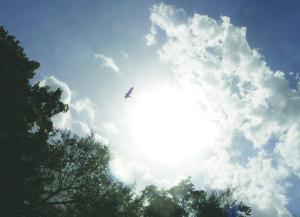At the end of the last column, brothers Roy Wayne and Tom Morton and I were sitting in a cave above the river praying the raging thunderstorm would end soon. I remember Chinese philosopher Confucius saying, “It is better to sit in a cave and watch the storm than to sit in the storm and look for a cave.” Anyway, I think it was him who said that!
We had seined up a good batch of live bait but thank goodness we had not tied out the trotlines yet. If we had, a rising river would likely have taken them that night. It was chilly in the cave because we were so wet and I was still vibrating slightly from the effect of the lightnin’ bolt which struck the barbwire fence I was straddling minutes before.
OUTDOORS
The Storm of Squire Lee’s – Part 1

The deep dark waters of the bell rock eddy awaited us as an afternoon storm warned us away. Squire Lee was an old country gentleman who lived on a sloping hillside above the river. His home was not far from the little cabin where my dad spent much of his childhood. In the river... [More]
Pleasanton catfish tournament hosts a night of fun and fishing

The Pleasanton East Lake was the location of the annual Pleasanton Catfish Tournament that was held on the evening/night of June 28. The tournament was well-attended this year with 28 fisherman and 15 boats. The tournament had good weather for fishing so the contestants were... [More]
The Toughest Fish

I figure the toughest little fish in the Midwest, and the Ozarks, is the green sunfish. You might know him as the black perch. He can get over a pound in size, and I remember catching them 8 or 10 inches long. They survive everywhere… in the muddiest, smallest farm ponds,... [More]
More Outdoors
NEWS
SPECIAL: Resurfacing on U.S. 59 in Anderson County to begin in August 4

A Kansas Department of Transportation (KDOT) resurfacing project on U.S. 59 in Anderson County is scheduled to begin the week of August 4. The project will resurface 15 miles of U.S. 59 using a hot-mix asphalt overlay, beginning at the Allen/Anderson... [More]
Commissioners vote to exceed revenue neutral

Set public hearing for Aug. 25 Near the end of the July 14 meeting, the Linn County Commissioners opened a discussion on the 2026 proposed budget with Commissioner Jim Johnson attending only this portion of the meeting via telephone and budget consultant Scot Loyd... [More]
Mulberry Limestone CUP approved by P & Z

A conditional use permit to form a rock quarry at 2400 and Valley Roads in March of 2024 has once again come before the Linn County Planning & Zoning Commission Tuesday night. The quarry, projected to be 48 acres to produce high-grade limestone qualified for use in both... [More]
More News
- SPECIAL: Benefits question an issue for county employees
- Commissioners discuss various budgets
- City learns of fire gear condition
- La Cygne leaders discuss food truck follow-up
- special: SCOTUS agrees to hear Women's Sports Case
- SPECIA;: Schmidt Votes to Cancel Massive Tax Hike, Secure Border, and Lower Federal Spending
- NOTICE:
- Pleasanton awarded $617,000 KDOT street grant
COMMUNITY
Benefit dinner and auction July 26

Trumbley recipient of proceeds On July 26, the 4H Building will be the site of a benefit dinner and silent auction in honor of Megan Trumbley who is currently battling cancer. Megan is undergoing radiation and chemotherapy treatments and the benefit is being held... [More]
Wade recounts WWII experience in South West Pacific theatre

Roy Wade sat at his son and daughter-in-law’s home with a stack of well-organized notes, maps and historic documents, notes that gave cliff notes of a life lived almost 82 years ago during WWII. Wade was drafted, like other men 18 years of age and older during the war,... [More]
Cultivating Kindness film crew win Telly Awards

On April 27, local filmmaker and producer, Sue Vicory held a premier for her newest film, Cultivating Kindness, at the Blue Moon Youth Center in Blue Mound. At that time, several community members involved in creating the film, along with all of the USD 346 students who were... [More]
More Community
- Local roots bring couple back to familiar territory
- Remembering those who gave all
- Prairie View FFA captures State Ag Mechanics Championship
- Free summer meals for kids age 1 to 18 in Pleasanton
- New rescue seeks donations to aid startup
- Cultivating Kindness film premiere held on April 27
- Jayhawk Linn to present ‘Maid to Order’ for spring play
- Students surprise teacher with bell ringing



